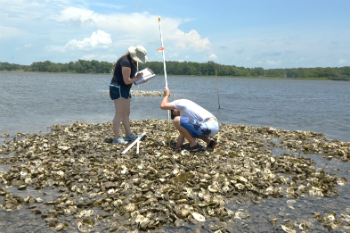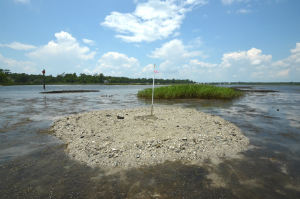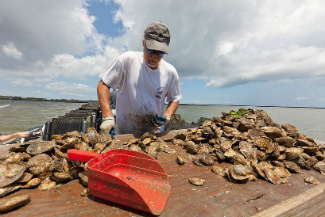MOREHEAD CITY — The oyster season opened in North Carolina on Wednesday, and officials with the state Division of Marine Fisheries believe the harvest will be a good one in most areas.
The relatively small daily commercial limit in southern waters of five bushels per person or 10 bushels per operation in some waters has some fishermen griping, but it will be just fine with waterman Sammy Corbett of Hampstead.
Supporter Spotlight
“It’s plenty,” said Corbett, a member of the N.C. Marine Fisheries Commission, the policy-making arm of the division. “Some people would like to raise it to 10, but I’m dead set against it. We’ve got a decent population of oysters, but there are just so many people who will be out there down in this area. We haven’t been able to get any shell planted the last couple of years, and we can’t just keep taking without putting something back.”
The fisheries division, because of budget cuts, largely eliminated its shell recycling program, although it still operates on a very small scale. As a result, Corbett said, a program that had been a tremendous help – the shells attract oyster spat that generally grow to 3-inch market-legal size within three years – has gone dormant, and pressure on the stock has not and will not decrease.
Besides, Corbett said, a man who works hard can earn good money on five bushels a day. “You’ll probably get $30 to $35 a bushel, five days a week,” he said. “That’s $150 or so a day, $750 a week if the weather allows you to get out every day. That’s more than most people make.”
Craig Hardy, lead oyster biologist for the division, said that state sampling has found lots of oysters, particularly around Pamlico Sound and in typical harvest areas of Carteret County.
In fact, Hardy said, the apparent healthy state of the oyster population – so far – was actually a little surprising, given the water temperature and weather conditions along the coast this spring and summer.
Supporter Spotlight
Because of that, there’d been some thought of delaying the usual Oct. 15 harvest opening, but officials agreed on Oct. 2 there was no reason to do so.
“We’ve had a lot of rain, and the water temperature is still pretty warm,” Hardy said. “Given that, you’d think it might not be so good, but there seem to be good numbers most places.
“Down south (Cape Fear area) doesn’t seem to be quite as good – the water’s even warmer down there – but overall, if nothing changes, it looks like it might be a pretty good year.”
Rosy Outlook
One reason for the relatively rosy early outlook is that dermo, the parasitic disease that ravaged state oyster beds for years and killed the shellfish before they reached legal harvest size, has been declining in prevalence.
Hardy said the disease thrives in salty, dry conditions, which have been the general rule, but oysters might finally be developing resistance.
 Two volunteers with the N.C. Coastal Federation take measurements of one of the 21 oyster shell patches the federation put into the Lockwood Folly River this year as part of its work to improve coastal water quality. Oyster shell planting efforts like this one help buoy oyster stocks, according to Craig Hardy, the lead oyster biologist for the N.C. Division of Marine Fisheries. Photo: Tess Malijenovsky |
“We’ve been hoping that for a long time, and although there’s not really been much research, it looks to me like it’s happening,” he said. “We’ve had a good bit of rain this year, but before this it’s been pretty dry – that’s what Dermo likes – and we’ve been seeing (the prevalence) of it going down for some time.”
Indeed, the oyster stock and the harvest have been rebounding in recent years, to the point that Hardy, with a tiny bit of hesitation, now calls it “stable.”
In 2013, N.C. watermen landed 586,689 pounds of oysters, worth $3.35 million, according to reports the division compiled from the harvesters. That was up from 440,063 pounds worth $2.57 million in 2012, but well below the 800,453 pounds and $4.48 million in 2011. Still, last year’s figures were generally in line with a recent positive trend in one of the state’s oldest fisheries, which was in big trouble a couple of decades ago.
In 1987, the commercial harvest totaled 1.42 million pounds worth $2.88 million. By 1994, after a decade or more of dermo, it had hit its low, of about 184,000pounds, and the harvest didn’t top 300,000 pounds again until 2005.
That’s not a lot if you go way back – in the 1880s, according to Joel Fodrie, a researcher at the UNC Institute of Marine Sciences in Morehead City. Historic catch rates in North Carolina were at 5 million pounds of oyster meat harvested each year, he noted, — but thanks to a variety of factors, including habitat loss and shellfish water pollution, nobody thinks those days will ever come back.
Still, Hardy believes the stock, buoyed by the state’s shell planting efforts and similar projects by the N.C. Coastal Federation and other private groups, is probably sustainable within reasonable variation and with sensible limits. The division’s 2014 stock status report lists the oyster as a species of “concern,” but Hardy thinks the agency’s season-opening proclamation set those reasonable limits.
Oyster Regulations
Oysters can be taken by hand and hand-operated implements only. Oysters may not be transferred from the harvesting vessel to any other vessel during oyster harvesting operations or be transported by any vessel other than the vessel in which they are harvested, in order to enable the division to keep close tabs on the harvest. It is also unlawful to possess commercial and recreational limits of oysters aboard the same vessel, and it’s unlawful to sell oysters taken on Saturday and Sunday from public bottom. Commercial oyster harvest will be allowed Monday through Friday of each week.
Recreational fishermen can take oysters for personal consumption only and are limited to one bushel a day, not to exceed two bushels per vessel per day. Oysters must be at least three inches long.
 Part of the problem of financing oyster habitat enhancement work is that the price of oyster shells has increased significantly, said Craig Hardy, lead biologist with the N.C. Division of Marine Fisheries. The N.C. Coastal Federation is experimenting with using alternative materials like marl (above), a marine limestone, that cost less. Photo: Tess Malijenovsky |
Julius Morris, a commercial fisherman in Atlantic in eastern Carteret County, has been oystering for seven or eight years and plans to be out there again this year. He said he hasn’t “looked around” to see what’s available yet, but noted that last year was pretty good and “I left some good oysters out there” when the season ended.
Based on that, he said, “I feel like there ought to be a pretty good crop out there. There are some good natural rocks and some that have been planted by the state. Like everything else in commercial fishing, though, it runs in cycles, it comes and goes. You never know for sure.”
Cycles, he said, are partly dependent upon weather and climate, but also partly dependent upon effort. For example, the recent upswing in oysters has been somewhat uneven, and part of the reason is economics.
“About five or six years ago, we had some really good years, and there weren’t that many people doing it,” he said. “But then the economy collapsed and the construction died and a lot of people got back into it. That influx of people had an effect on it.”
While he feels pretty good about the current state oysters, Hardy would like to be able to do more to improve the stock. “I’d like to do more, but budget cuts haven’t just affected the fisheries division, they’ve affected all of state government,” he said. “The good thing is that I think people do care about the oyster stock, partly because of oysters’ positive impact on water quality, and people want to help.”
The federation, for example, has for years now been planting oyster shells, forming reefs that both enhance the stock, filter the water and serve as effective natural alternatives to shoreline erosion control structures, such as bulkheads. And the division, Hardy said, is looking at ways to continue its habitat enhancement work at a lower cost.
Part of the problem, he said, has been a significant rise in the price of oyster shells, as more states and groups have gotten involved in planting efforts. So the state is studying the use of other materials, such as crushed concrete, that cost less. The idea is to plant alternative materials side-by-side with oyster shells and examine the results.
Hardy is also encouraged by a continued increase in interest in oyster mariculture. Although entrepreneurs have long farmed clams, and watermen have held leases of public bottom on which to grow oysters and to transfer oysters from polluted waters, some are now growing oysters caged in the water, not on the traditional oyster rocks.
 This is an oyster farm in Core Sound. When oysters are grown this way in floating cages, they grow as singles, not in clusters, and don’t get covered by the mud. Photo courtesy: Jay Styron/Carolina Maritime Co. |
Some, including Carolina Mariculture, operated by Jay Styron off Cedar Island in Carteret County, grow oysters in floating cages, suspended in the water on rope lines. The shellfish grown this way don’t get covered in the mud, and they grow as singles, not in clusters. They are rounded – more attractive to consumers who like them “on the half shell” – and they bring a higher price. Restaurants like these oysters, Corbett said, because they’re more reliable, not as subject to the caprices of nature.
“One guy I know sells them all summer to restaurants and he makes a good living,” said Corbett, the fisheries commission member from Hampstead. It’s a pretty oyster, much better than what you get that time of year from Louisiana, and it sells for 65 to 70 cents apiece. That might not sound that good, but it’s a premium price. If you’re selling wild oysters by the bushel, you might not get more than a nickel apiece.”
Hardy thinks oyster mariculture will continue to grow. He also noted that some are using triploid oysters – they don’t reproduce so they grow faster, reaching market size in two years – and he’s excited about the future of the growing sector of the fishery.
There is still some resistance to mariculture; folks are accustomed to wild-caught seafood, and the typical N.C. commercial fisherman is fiercely independent and reluctant to give up his way of life. Hardy doesn’t want to see that disappear, either, and thinks there’s plenty of room for both oyster fisheries. And both, he said, contribute to water quality preservation and enhancement because all oysters, wild or farmed filter out pollutants as they feed.
Jerry Schill, president of the New Bern-based N.C. Fisheries Association, the state’s largest trade and lobbying group for commercial watermen, said he still thinks that the oyster fishery is important, both to those who profit from it and from the water quality standpoint.
 Jay Styron culling, grading and sorting oysters. Photo courtesy: Jay Styron/Carolina Mariculture Co. |
“It’s part of the state’s culture, too,” he said. “We as an organization probably aren’t as involved in it as we should be, not as pro-active, but part of that is we have so many other battles to fight and our resources have been limited. Plus, the old saying that, ‘the squeaky wheel gets the grease’ is true. We don’t hear as much about the oyster fishery from our members as we do about big issues, such as inside trawling. But there’s no doubt it’s an important fishery, and we certainly support efforts to improve it.”
So does Earl Taylor, owner of T&W Oyster Bar on N.C. 58 in the Peletier community in western Carteret County. Nearly two weeks before the opening of the season, customers were clamoring for local oysters, he said.
“I’ve had a lot of people asking when we’re going to get them,” said the owner of a restaurant that for decades has thrived, despite its out-of-the-way location, because of its reputation for excellent oysters. “In fact, they’ve been asking since August.”
Taylor gets most of his oysters from the Newport River area, and said he doesn’t really know quite what to expect this year.
“I haven’t really heard much,” he said. “Most of the guys I normally buy from are still shrimping and haven’t had much time to look around yet. But we had a real good year last year – lots of really pretty and big local oysters – and I’m hoping it’ll be at least as good or better this year.”







